Adding screen real estate with a ViewSonic VX2776

Getting your workspace right can be hard, especially when you're a home worker. There's a strong temptation to tweak everything until it's just right -- that's what I do with my desk, adjusting monitor height, tweaking my various screens, and getting just the right setup for ShareMouse, the keyboard and mouse sharing tool I use to control multiple machines from one keyboard.

ViewSonic's VX2776-smdh
I've recently completely changed the way I work at my desk, bringing in a new primary computing device and adjusting the layout of my monitors. It's a layout with one 24-inch and one 17-inch screen, as well as two laptops, which means there's not much space for more screen real estate. So, when I took a look at ViewSonic's 27-inch VX2776, my first thought was that there wasn't going to be any space on my desk.
Luckily I was wrong.
For a 27-inch screen, it's surprisingly small and thin, with narrow bezels. In fact it's not much bigger than my existing 24-inch screen, and has the same HD pixel resolution at 1,920 by 1,080 (a QuadHD version is also available).
Even so, it was a bit of a tight squeeze when I replaced my ageing 17-inch panel. Much of the screen is very thin indeed, with a small bulge at the bottom for the control circuitry. That's good for a reasonably priced device, currently selling for around £199. It's not a budget monitor, but its size and features are respectable for a mid-price screen.
The VX2776 is one of the thinnest monitors I've tested.
One reason the VX2776 is small and light is that it has an external PSU, which does make quite a difference in weight and size. It also means that you can quickly replace a PSU if it fails (and you don't have to unsolder and replace capacitors to get a failed display working again!).
It's not all perfect, of course, and there are some issues with the monitor. Perhaps the biggest and most obvious was the fit of the monitor stand. It's a two-part unit with an angled piece of metal that plugs into the back of the screen. As the monitor had to be returned I didn't feel I could push the connector in all the way, as it locks extremely firmly and will be very hard to remove. I also found its built-in speakers relatively poor, preferring the sound quality from my Surface Book.
The VX2776's monitor stand is hard to fit, and harder to remove (there's also no VESA option).
There's plenty you can tweak using the rather awkwardly-placed onscreen controls. Four buttons let you navigate through menus, but it's very easy to press the wrong button and have to start all over again. Perhaps it's lucky that the default settings suit most common use cases, so you don't have to spend time pressing tiny buttons and remembering just what each button does.
Part of my recent reworking of my work space has meant switching from using a traditional desktop as my primary computer to using a Surface Book, I decided to connect the ViewSonic to a Surface docking station using its Mini DisplayPort connector. Hooking the dock to the screen's DisplayPort adapter was easy enough, and I was presented with a mirrored copy of my device's screen that I quickly switched to being an extended secondary display.
Image quality was excellent, and I was able to use it as part of my photo-editing toolset, previewing images that I'd edited in Lightroom before sharing them on Flickr.
While display quality is good, it's not the fastest of displays, so don't expect to use it as part of a high-end gaming rig. Despite that, it's more than capable of handling business graphics, photo-processing, and web design -- all scenarios that need a good quality display that doesn't break the bank.
ViewSonic notes that the display has a blue-light filter, which is meant to make it more restful to use, with less eyestrain (and perhaps more importantly, making sure you don't get blasted with blue light resetting your sleep cycle). I didn't notice it making too much of a difference, but that may be more to the fact that I use LED lighting on my desk and had three other screens in action much of the time.
Will I miss it when it goes back? I'm not sure. It certainly gave me a lot more space for my email, which is what I ended up using it for most of the time. But you can fill any monitor with a copy of Outlook, so I'll wistfully look at its box as I hook up my nearly 15-year-old 17-inch screen again and get back to work.